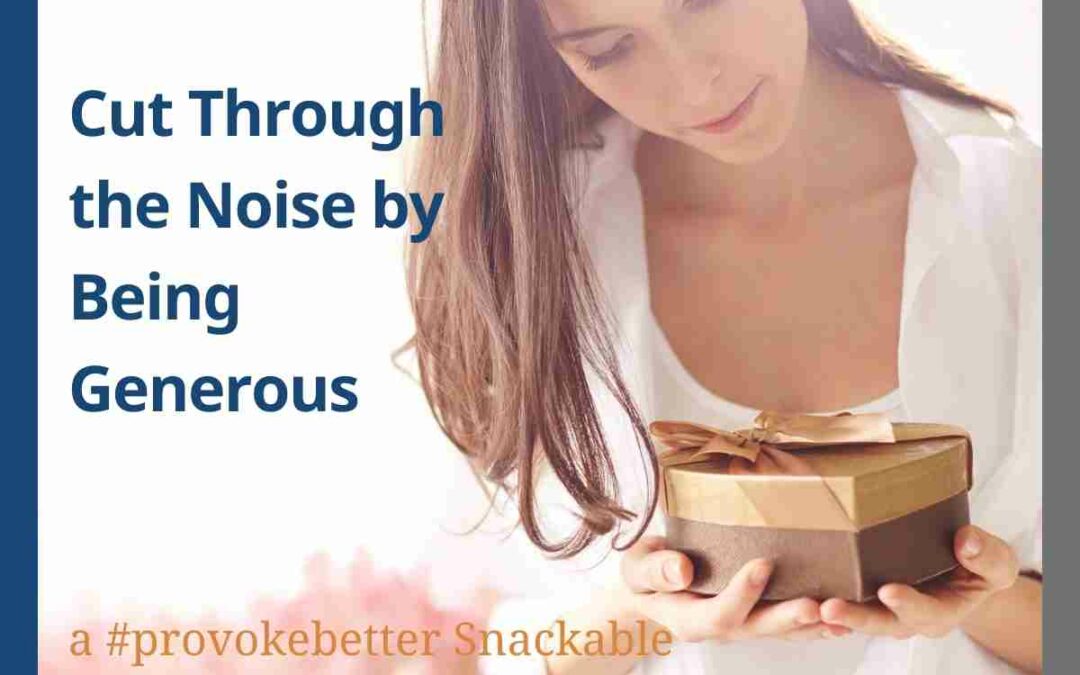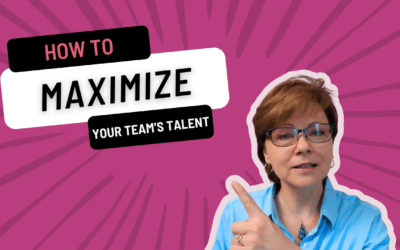Generosity does not start with a checkbook. It starts with a mindset.
The text below is adapted from a Live Stream conversation.
I’ll pick a new topic and will share some insights, best practices, and some of the things that I’ve learned, not just in running my own business for over 15 years, but in working with dozens of other business owners.
My hope is that you will grab some shortcuts that you can implement immediately in your business to make a difference in your bottom line, to make a difference in your recruitment and retention efforts, and in just how much joy you experience working at your companies and being in business.
Generosity is something that I have found to be good for my karma and good for my business.
It helps me get out of my own head when I’m thinking about other people. And feeling generous and expressing that generosity is the best way for me to do that.
I will borrow a phrase that I heard from Marlene Young, who is a leader here in Frederick County, Maryland. I saw her at an event that the Chamber of Commerce hosted a few weeks ago called She Week.
When talking about paying it forward, sometimes we get to do it in a very specific way to the individual in front of us. And sometimes in less specific ways to the community at large.
In She Week, Marlene Young said: “Generosity, paying it forward, doesn’t start with a checkbook. It starts with a mindset.”
And I couldn’t agree more with that. I think that we have to start thinking generously first before we start participating generously.
Generosity does not always mean that you have to write a check, pay for a big gift, or do something wild and extravagant.
And today, I will share with you three different types of truths or “rules” that I’ve discovered about generosity.
I’ll also share some examples of how I’ve seen each one of these rules and principles play out in my business and the businesses that I work with.
First Rule: Every Action Causes A Response Action
The first rule about generosity in business is that every action we take will cause a response in someone else.
I mean, that’s something you’ve probably known since you were a kid, right?
Well, scientists in Switzerland have actually done some research that backs this up. They found that those who have felt someone else’s generosity are more likely to be generous themselves.
Seems common sense, doesn’t it?
It means that if you’re generous with your clients, your partners, your employees, and if you put in that little extra effort, it is more likely that they will return the favor.
‘You reap what you sow’ might be another way to think about this.
So let me give you some examples of what that might sound like:
- If you’re generous with somebody in a prospect meeting, they’re more likely to be generous with you in how responsive they are to your offer and how truthful they are in sharing with you what their needs are.
- If you’re generous with a client in the course of your relationship, you help build loyalty, trust, an advocate, and potentially a good referral source, because the Law of Reciprocity says: “when I’m kind to you, you’re more likely to be kind to me.”
Now, I don’t want you to hear this and think:
“Oh, well, she’s trying to get under my skin. This is manipulative.”
If that is your mindstate, please don’t do this. It’s a belief that we all may need to reframe at some point.
Again, paying it forward doesn’t start with a checkbook. It starts with the mindstate.
And as much as possible, I always encourage you to be doing that with an open heart, not thinking “I’m doing this so that I get that”.
You’ve tainted it, if you do that. You’ve already poisoned the well. Just be generous, because you want that energy, that karma, if you will, to go out into the world.
I think that what you put out will come back to you. So put out as much generosity as you can.
- Another example of being generous in business is giving small gifts, which can also help open the door in a new relationship.
Case Study: Being generous as a prospecting technique.
I consulted with a technology client who was in the energy space.
They help large corporate buildings by providing more energy-efficient solutions, tracking where the energy is going, where energy is leaking, and then finding ways to correct it.
This client was having trouble breaking through the door to get to the key decision makers: the building engineers and the building managers. Since they were the ones responsible for the buildings, my client wanted to initiate a conversation with them.
However, these engineers weren’t usually sitting at a desk emailing a lot. They were hard to reach. And so, getting to that key decision maker had become a problem for this technology company in the energy space.
So we came up with this idea that provided a bit of a generous gift that was very low cost to those engineers.
We said: “What is it these engineers, these building managers want? Well, they probably want a break. They probably want somebody to pay attention to them, and take care of them for a change.
What if we got doughnuts and spontaneously showed up at the buildings that we’ve identified would be great prospects for us?”
We would show up to these buildings and say: “Hey, we brought so and so a dozen donuts. Are they available?”
Now what did we do? For most cases we were reaching the receptionist, who probably said something like: “Okay, there are donuts here, this is a little low out of the ordinary.” So we’d already broken through the noise.
Secondly, we arrived with a gift. And what does a dozen donuts cost? It’s pretty inexpensive.
And then we added a little bit of marketing savvy to that gift, which drew in this idea of the doughnut, and drew a line between the doughnuts and this energy solution that the company was doing.
The result was a very simple postcard that went with the doughnut box that helped us give it context and made it full circle.
The postcard said: “Are there holes in your energy solution?”
So we came up with a fun way to tie those two ideas in together. And on the back of it, it was just an invitation to have a conversation and show the benefits of the solution, and how this solution could help pay for itself in less than a year and contribute to a 15% ongoing annual savings.
Pretty compelling offer.
The company that did this got about 15 dozen donuts. They had been trying to reach out to these prospects, but had been unsuccessful. In the course of a day they did all of the deliveries for these doughnuts.
After this simple act of generosity, they got to meet with about 70% of the engineers and building managers that had been impossible to get ahold of before.
For those conversations that they had, they were scheduled for demos.
In the first two weeks, they were able to break through the noise and get more response through that one day of doing hand deliveries of very low-cost doughnuts than they made in the three prior months trying to get a hold of these very same people.
And how did it start? It started with a posture of generosity.
So think creatively. How could you incorporate that small gift?
P.S.: I thank my buddy Karen Justice for this. She always recommends sending out thank you notes in November instead of holiday cards in December.
And why is that? Everybody sends the holiday cards in December. Everybody sends the End of Year cards at the end of year. And so your message is out there with everybody else’s message.
But if you back the timeline up a little bit and express your gratitude, you’re generous with your expression of your gratitude in November, you’re getting ahead of all the noise and, potentially, talking with the decision makers.
You’re making a wonderful impression with them before the end of the budget year ends in many cases. So, if they have a little money to spend, now you’re top of mind.
Once again, you’re top of mind and everybody’s smiling as they think about you.
So rule number one, practice the Law of Reciprocity, knowing that every action you take will be met, most likely, with a similar action.
Second Rule: Be Generous With The Intangible
Being generous can cost you next to nothing, and yet convey huge value. The doughnut initiative that I just described is a great example of that.
But you can get really creative and find low-cost ways to make a great impression.
Three examples from the hospitality industry.
One of our clients is Catoctin Wildlife Preserve in Thurmont, Maryland.
They have the option of hosting birthday parties for kids, and their parents, who are bringing all their guests to the Preserve for this party, are already spending a great deal of money.
So, looking at ways to be generous, the Preserve found that they could upgrade the birthday packages if they included special experiences or special access for the birthday kid that didn’t really cost the Preserve anything.
So they decided to get these little pith helmets, and gave one to the birthday kid. And what did that do? It set them apart right away.
The Managers in the Preserve also made sure that all the staff in the park knew that the kids wearing that helmet were birthday kids.
So the kid would get a happy birthday every time they passed a staff member: “Hey, happy birthday.” “Hey, happy birthday.” And those kids were feeling GREAT.
Also, the birthday kid would have VIP front-row sitting at any special and educational show happening during the day.
That pith helmet was probably $2.50, but making the kid -and the parents- feel special, didn’t cost the Preserve a cent. But now the birthday kid and eight of their guests are sitting right there in the front row. So they’ve got that access they couldn’t otherwise buy.
And if there was an opportunity to get a volunteer from the audience to help with the chinchilla, or the baby alligator, guess who got to come up on stage? The birthday kid, in their pith helmet, for an amazing photo that mom and dad were almost guaranteed to share on social media.
Again, a huge added value that didn’t really cost the Preserve anything. But to that family, to that birthday kid, it was an experience they couldn’t otherwise purchase.
It was access and recognition and a memory that is going to stick with them forever.
Generosity can come just as easy as that.
A different example from the hospitality industry comes from a campground that I work with. They have camping rentals: RVs and small cabins.
They have a system so that every time a guest checks in, the campground has fresh cookies to share with them.
It’s marvelous, again, doesn’t really cost them anything. But they’re nicely packaged, they have a beautiful little cellophane bag that they put them in and there’s a tag on it.
As we were working together, I reminded them that the tag is sometimes the thing that people will photograph.
So we made sure the tag was beautiful, was branded, and provided a hashtag that the guest could use if they decided to share the post.
By doing this, the campground gave their guests all of the ammunition they needed to help advocate for them.
In addition to that, for the cabin rentals, I said:
“Well, let’s create a few more Instagram worthy moments. What if, when the guest arrives, inside the cabin, you’ve got a little whiteboard or chalkboard where you’ve written their name on it:
Welcome, Whitney and guests hope you enjoy your weekend.”
A little piece of chalk, one per cabin. Again, two or three bucks to do that. But guess what I’m doing as soon as I get in? My name is there.
Dale Carnegie taught us that there’s nothing more beautiful than our own name. My name is there. And I’m gonna take a picture of that and guess what goes out in social media?
So that generous act made it very, very easy for people to share our message and create that connection between the experience and the brand. Beautiful examples cost them next to nothing to do.
I have a third example from being generous in the tech world: implementing trial periods. Also, customer calls are great examples of that.
I’ve got an IT client who does what he calls “can’t fail calls” about once a month with the people that he’s working with.
Another no-code workflow solution company does monthly Mastermind Calls. So they do small group calls with their users, particularly their high-use users.
And what they found is that, not only are they reinforcing the two way relationship, but they’re also getting from these high-use customers some amazing feedback on their products that has actually influenced the trajectory of upcoming features and solutions.
So that little investment that they spend in time pays huge dividends, not just in customer loyalty, not just in potential referral sources, but in innovative ideas for how to continue to make their product even better, even stronger.
Third Rule: Remember To Be Generous With Your Employees
Third, and final generosity tip is just that generosity can come in many forms. We’ve already shared some examples about how generosity doesn’t necessarily have to be a gift that I could hold in my hands.
Generosity can also be knowledge, like this Snackable Series. It could also be extra time that you’re giving. It could be patience, it could be mentorship. Probably a dozen different things.
So think about how generous you can be with prospects, with customers, and with employees. And this is the one that I want to focus on in this example.
A friend of mine said to me years ago: “How you part ways with employees can say a lot more about you than how you started the relationship.”
Always be just as generous as you can with them on their way out the door, as you are when they came in.
Now in today’s climate, I know a ton of businesses are struggling with employee recruitment and retention. If you’re being generous, as generous as you can be with your employees, while they’re employees, they’re much more likely to stay.
And even if they leave, they’re much more likely to think and speak of you fondly and potentially bring other people to you even as they’re leaving your organization. They didn’t necessarily leave for bad reasons.
Maybe their spouse got reassigned, and they’re moving out of the area. Maybe they’re having a kid and deciding they want to take time off. Right?
There are a million reasons that you can leave an employee on good terms. But if you’re generous with them during their employment, you’re going to make that great relationship stick long after the paycheck stops coming.
And again, generosity doesn’t have to start with your checkbook. Right now I think there’s an overemphasis on signing bonuses and, say: “three months and we’ll give you this other onboard bonus.”
And then, what happens to all the employees who have been there loyally doing what they need to do for the last three, or four, or five years? Did you suddenly forget about them?
It’s like all the brand new customers at the cellphone companies. They get all the best deals, but the long term customers… They don’t get any of the good deals.
So think about how generous you may be with your employees. Are you giving them access to mentorship? Are you giving them access to professional development opportunities and a stipend to do that?
Even as a small company, I never had more than 10 employees. But we made room for those employees to experiment with different techniques, for them to attend seminars, workshops, webinars, and conferences.
And we supplemented their time and their registration costs to go do that. Because without fail, when we did, they came back smarter. They came back with something that they could share with the rest of the team.
They came back with something they could apply to a new project, with something they could wow a client with. Always, always, always. I never regretted that decision.
How generous are you being with your professional development allocations for years for your employees?
How generous are you when they make a mistake?
How generous are you when they risk and fail?
I remember very clearly a conversation I had with Flying Dog Brewery, just down the road from where I live in Frederick, Maryland.
Flying Dog has a perspective that they share with all of their employees that says: “If you don’t screw up every now and then, you’re probably not trying hard enough. You’re probably not innovating enough. If you never make a mistake, you’re playing it too safe.”
So generosity in this case could be asking yourself:
“What are the guardrails in this company? Are your guardrails so specific that your people cannot innovate, ask questions, or risk anything?”
In some industries, I could understand why that would be the case. But in many industries, we can build trust, and over time, we can widen those guardrails.
And even if somebody bumps around a little bit, it doesn’t mean the end of the relationship. Just be as gracious and generous with them, as you would want someone to be with you and, and see how much more loyal you get.
And remember that how you part ways with your employees is going to say as much about you as how you brought them in.
So, even after they’ve given notice, can you be generous with a recommendation? Can you be generous with understanding what they need to move on and be successful in their next position?
As a leader of an organization, I’ve had many employees, who, after a period of time, have learned everything that they can learn from me, and they’re ready to stretch their wings someplace else. And I take that as a win.
Of course, I miss them. Of course, I miss their talents. Of course, I miss their contributions to my company. But in some ways, I feel kind of, you know, that little proud mama moment. And that’s a different sort of generosity that I will, I will never regret. I always feel good about that.




